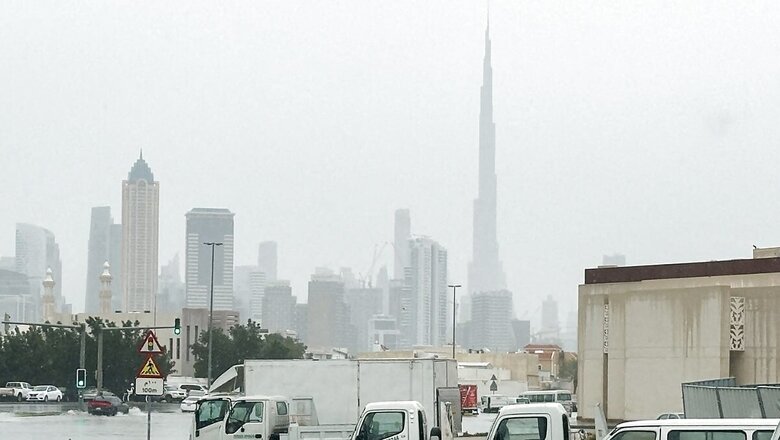
views
The record-breaking rainfall in Dubai this week has left the world puzzled. Situated within the Arabian Desert, one of the fastest-growing cities known for its soaring skyscrapers and opulent infrastructure has been brought to its knees by torrential rains that have triggered disastrous floods.
According to the United Arab Emirates (UAE) National Meteorology Centre, the city recorded a year and a half’s rain in just a few hours. The city of Al Ain received 254 mm in less than 24 hours on Tuesday — the highest ever since the records began.
The meteorologists say the rainfall was triggered by a high-intensity storm passing over the region – these systems originate in the Mediterranean Sea and move eastwards. However, this time, it unusually extended far to the south.
INTENSE STORM FUELLED BY GLOBAL WARMING?
“There was a mid-latitude westerly trough from the Mediterranean Sea which became so strong, that it also extended southwards towards the UAE. Normally, it affects the upper reaches of Afghanistan, Pakistan, Kashmir, Himachal, and Uttarakhand even closer to Tibet, but it went unusually far to the south. So the rainfall in Dubai was preceded by flooding in Oman and adjoining Saudi Arabia,” said Dr KJ Ramesh, former chief of the India Meteorological Department (IMD).
The storm was further fuelled by additional moisture from the Arabian Sea concurrently giving extreme rainfall over Bahrain and Qatar.
But it is clearly not a one-off incident. Extreme weather events, especially short bursts of torrential rain, have intensified globally leading to disastrous floods.
Massive amounts of greenhouse emissions pumped into the atmosphere by human-led activities have raised global temperatures, making the world over 1.1℃ warmer already.
“Whatever may be the trigger, it is certain that global warming has intensified heavy rainfall events. Though the overall number of rainy days is less, the amount of rainfall on those days has increased significantly. This is because a warmer atmosphere can hold more moisture, and sustain strong, deep clouds for a long duration which leads to a sudden downpour,” added the senior atmospheric scientist.
CLOUD SEEDING GONE WRONG?
Experts have also addressed the widespread debate over whether the existing rainfall event was inadvertently exacerbated by artificial cloud seeding. This is a scientific method of modifying the weather by dispersing large salt particles into convective clouds through an aircraft to increase the overall precipitation. The UAE’s National Centre of Meteorology was one of the first in the Arabian Gulf region to use cloud seeding and has been using it for more than a decade to incrementally increase rainfall. This is done using a private airplane supplied by special salt flares manufactured to fit with the nature of the physical and chemical properties of the clouds that form in the UAE.
According to Professor Sachchida Nand Tripathi, from the department of civil engineering at IIT Kanpur, who has also been associated with cloud seeding experiments in India, it is highly unlikely that the rainfall was triggered by such an exercise. One of the reasons is that artificial seeding is done during the early stages of cloud development. But if a storm is well-developed, seeding is usually not recommended.
“Globally, there is a general consensus among scientific agencies that cloud seeding can bring about a 15 to 25% increase in rainfall. So if we go by this data, it would have still rained heavily in Dubai. So, it is highly unlikely that the event could be attributed to seeding,” said Prof Tripathi. “Moreover, the objective of artificial seeding is to manually alter the natural development of the cloud to enhance precipitation. Many times we see in arid and semi-arid regions that clouds form, but they do not lead to enough rain, so this technology can be helpful.”
Several states in India including Andhra Pradesh and Tamil Nadu have also experimented with this technology for inducing rain in semi-arid regions.
Recently, the Indian Institute of Technology (IIT) Kanpur also completed trials using its seeding equipment and a fully-equipped aircraft, and is planning to extend it soon.
RISE IN EXTREME WEATHER EVENTS GLOBALLY
The intensity of rainfall in Dubai has been so high that it has overwhelmed the desert city, leaving its existing drainage system struggling to cope. The internet has been abuzz with videos of cars floating along the roadsides, flooded runways, and submerged buildings across the city.
The science is clear. The human-induced climate change is set to make such extreme weather events more intense, frequent, and disastrous in the near future. According to experts, the emphasis should now be on doing a structural audit of the lifeline infrastructure and making it more resilient to face such events.




















Comments
0 comment